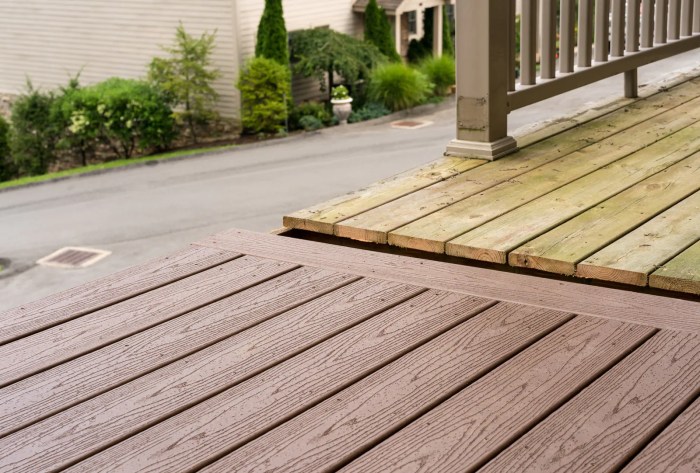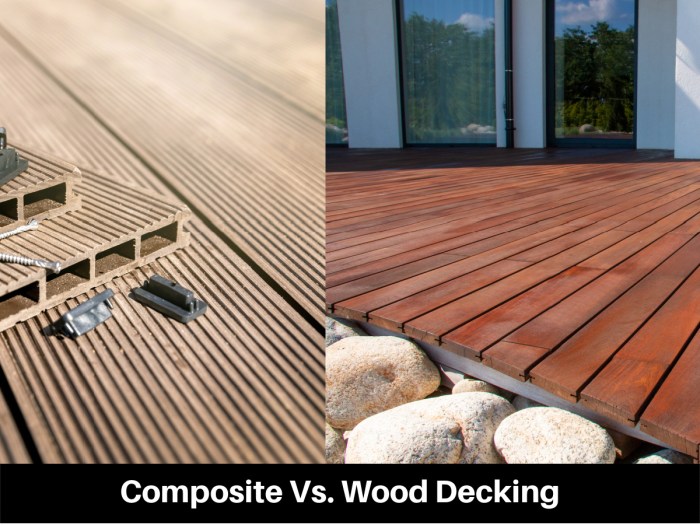Exploring the world of decking materials, this article delves into the differences between composite and wood decking, offering valuable insights for those looking to upgrade their outdoor spaces. From durability to maintenance requirements, we cover it all in this informative piece.
As we navigate through the intricacies of composite and wood decking, readers are sure to gain a deeper understanding of the pros and cons associated with each material, aiding in their decision-making process.
Composite Decking
Composite decking is made up of a combination of wood fibers, plastic, and a binding agent. This mixture creates a strong and durable material that mimics the look of real wood.
Comparison of Durability
Composite decking is known for its superior durability compared to traditional wood decking. It is resistant to rot, mold, and insect damage, making it a long-lasting option for outdoor spaces.
Maintenance Required
One of the main advantages of composite decking is its low maintenance requirements. Unlike wood decking, composite decking does not need to be stained, sealed, or painted. Regular cleaning with soap and water is typically all that is needed to keep composite decking looking great.
Wood Decking
Wood decking is a popular choice for outdoor spaces due to its natural look and feel. There are different types of wood commonly used for decking, each with its own characteristics and benefits.
Types of Wood for Decking
- Cedar: Known for its natural resistance to rot and insects, cedar is a popular choice for decking. It has a warm color and pleasant aroma.
- Pressure-Treated Pine: Affordable and readily available, pressure-treated pine is treated with chemicals to resist rot and insects. It can be stained to enhance its appearance.
- Redwood: Redwood is a durable and attractive option for decking, with natural resistance to decay and insects. It has a rich, reddish-brown color.
- Ipe: Ipe is a hardwood known for its strength and durability. It is resistant to rot, insects, and decay, making it a long-lasting choice for decking.
Natural Characteristics of Wood Decking
Wood decking is prized for its natural beauty and warmth. Over time, wood decking can weather and develop a patina, adding to its charm. However, wood decking requires regular maintenance, such as staining, sealing, and occasional repairs to keep it looking its best.
Cost Comparison
Wood decking is generally less expensive upfront compared to composite decking. However, due to maintenance costs over time, wood decking may end up costing more in the long run. It is important to consider both the initial cost and long-term maintenance when choosing between wood and composite decking.
Installation Process
When it comes to installing decking, whether it's composite or wood, the process can vary. Let's take a look at the steps involved in installing composite decking, the tools required for installing wood decking, and compare the ease of installation between the two materials.
Composite Decking Installation
Installing composite decking typically involves the following steps:
- Prepare the substructure by ensuring it is level and sturdy.
- Install the composite boards using hidden fasteners for a clean look.
- Trim any excess material and finish the edges for a polished appearance.
Wood Decking Tools
When installing wood decking, you will need the following tools:
- Hammer or nail gun for securing the boards.
- Circular saw for cutting the boards to size.
- Tape measure for accurate measurements.
Comparison of Installation Ease
While both composite and wood decking have their own installation processes, composite decking is generally considered easier to install due to the use of hidden fasteners and the lighter weight of the boards. Wood decking, on the other hand, may require more manual labor and maintenance over time.
Environmental Impact

When it comes to decking materials, considering the environmental impact is crucial in making a sustainable choice for your outdoor space.Composite decking materials are known for their sustainability as they are often made from recycled materials such as plastic and wood fibers.
By using recycled materials, composite decking helps reduce waste and decrease the demand for new resources.On the other hand, the environmental impact of using wood for decking can be significant. Deforestation and habitat destruction are common issues associated with harvesting wood for construction purposes.
This can lead to a loss of biodiversity and contribute to climate change.
Sustainability of Composite Decking Materials
Composite decking materials are considered eco-friendly due to their use of recycled materials. This not only reduces waste but also helps lower the demand for new resources, making it a sustainable choice for environmentally conscious consumers.
Environmental Impact of Using Wood for Decking
The use of wood for decking can have a negative impact on the environment. Deforestation, habitat destruction, and the carbon footprint associated with harvesting and processing wood are some of the environmental concerns related to using wood as a decking material.
Comparison of Eco-friendliness
- Composite decking: Made from recycled materials, reduces waste, and lowers the demand for new resources.
- Wood decking: Contributes to deforestation, habitat destruction, and has a higher carbon footprint compared to composite materials.
Final Review

In conclusion, the debate between composite and wood decking continues to be a hot topic in the world of outdoor design. Whether you prioritize eco-friendliness or cost-effectiveness, there is a decking option out there that suits your needs perfectly. Dive into the world of decking with confidence after considering all the valuable information presented in this discussion.
Questions Often Asked
Is composite decking more expensive than wood decking?
Composite decking typically has a higher upfront cost than wood decking, but it requires less maintenance over time, potentially balancing out the overall costs in the long run.
What are the environmental benefits of composite decking?
Composite decking is often made from recycled materials, making it a more sustainable option compared to traditional wood decking. It also doesn't require harmful chemical treatments like wood does.
Which type of wood is best for decking?
Cedar and redwood are popular choices for wood decking due to their natural resistance to decay and insects. They are also known for their attractive appearance.